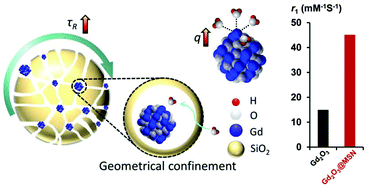Geometrically confined ultrasmall gadolinium oxide nanoparticles boost the T1 contrast ability†
Abstract
High-performance magnetic resonance imaging (MRI) contrast agents and novel contrast enhancement strategies are urgently needed for sensitive and accurate diagnosis. Here we report a strategy to construct a new T1 contrast agent based on the Solomon–Bloembergen–Morgan (SBM) theory. We loaded the ultrasmall gadolinium oxide nanoparticles into worm-like interior channels of mesoporous silica nanospheres (Gd2O3@MSN nanocomposites). This unique structure endows the nanocomposites with geometrical confinement, high molecular tumbling time, and a large coordinated number of water molecules, which results in a significant enhancement of the T1 contrast with longitudinal proton relaxivity (r1) as high as 45.08 mM−1 s−1. Such a high r1 value of Gd2O3@MSN, compared to those of ultrasmall Gd2O3 nanoparticles and gadolinium-based clinical contrast agents, is mainly attributed to the strong geometrical confinement effect. This strategy provides new guidance for developing various high-performance T1 contrast agents for sensitive imaging and disease diagnosis.


 Please wait while we load your content...
Please wait while we load your content...